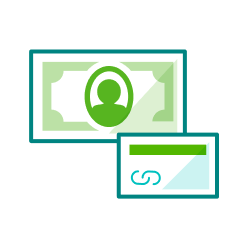Record a returned payment or bounced check
by Intuit•828• Updated 1 week ago
Learn how to use an expense to record a customer's bounced check in QuickBooks Online. Or follow these steps if you need to record one of your own bounced checks.
 Check out QuickBooks Payments rates and apply. Then, you can automatically process payments, deposit funds and record transactions in your books.
Check out QuickBooks Payments rates and apply. Then, you can automatically process payments, deposit funds and record transactions in your books.
If a customer's check bounces, you can record an expense and balance your accounts, then re-invoice your customer with any bank fees added.
Note: If you don’t want to expense the bounced check, you can record it with a journal entry.
Note: If you want help with this process, reach out to your accountant. This can get tricky and they know how to handle the next steps. Don't have an accountant? We can help you find one.
Prerequisites
To record a bounced check, you’ll need:
- The amount of the customer's check that was deducted from your bank balance.
- The fee your bank charged you so you can charge your customer (this is up to you).
You’ll also need an item in QuickBooks to represent the bank fee.
Step 1: Move the bounced payment to Accounts Receivable
When you move the bounced payment, you open an expense to account for the missing funds. This keeps your records correct and offsets the unpaid invoice.
Note: If your bank isn’t connected to QuickBooks, or the returned payment hasn’t shown up yet, make a new expense for this transaction. Then match it to your bank later.
Follow this link to complete the steps in product .
- On the Reviewed tab, find the bounced check or returned payment in the bank feed. Select it to expand the transaction details.
- In the Vendor/Customer ▼ dropdown, choose the customer whose payment bounced.
- In the Account ▼ dropdown, select Accounts Receivable.
- When you're done, select Add.
Step 2: Remove the bounced check payment from the original invoice
Follow this link to complete the steps in product .
- On the Customers tab, find and select the customer whose payment bounced.
- Find the payment for the bounced check and select Edit.
- Select the payment made link.
- Uncheck the box for the invoice that the payment had been applied to.
- Select the new expense you created in Step 1.
- Select Save and close.
- A message displays saying that the transaction is linked to others. Select Yes.
Step 3: Create an invoice for the bank fees to charge your customer
- Select + New.
- Under Customers, select Invoice.
- Select the Add customer ▼ dropdown and choose the customer whose payment bounced.
- For the Invoice date, use the date the bank charged the fees.
- In the Product/service column, select the service Bank Fees Charged to Customer.
- Enter the amount you want to charge the customer for the bounced payment. (You choose this amount.)
- Select Save and close.
Next steps
After recording the bounced check, send your customer a Balance forward statement to tell them what they owe and why. This statement includes both unpaid invoices.
Once they pay you, record their payment normally.
Related links
- Record a returned or bounced customer check using a journal entry
- Enter and manage expenses
- Create and send customer statements in QuickBooks Online
- What to do if your check bounces and your bank account has non-sufficient funds
- Record invoice payments
- Add an account to your chart of accounts in QuickBooks Online
Sign in now for personalized help
See articles customized for your product and join our large community of QuickBooks users.
More like this